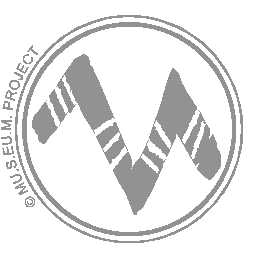|
||||||||||||||||||||||||||||||||
|
|
Museum of: Berlin | |||||||||||||||||||||||||||||||
| Name of the artefact: Anthropomorphic vessel | ||||||||||||||||||||||||||||||||
|
Foot vessel in form of a female figure with raised arms
and indicated breasts. |
||||||||||||||||||||||||||||||||
|
WHERE IS IT AND MAIN CHARACTERISTICS |
STATE |
|||||||||||||||||||||||||||||||
|
Department: |
Museum for Pre- and Early History |
Preservation: |
Very good | |||||||||||||||||||||||||||||
|
Inventory number: |
IVd 3564 |
Restauration: |
Restored | |||||||||||||||||||||||||||||
|
Name of the artefact: |
Anthropomorphic vessel |
Completeness: |
Complete | |||||||||||||||||||||||||||||
|
Object type: |
Vessel/Anphora |
|||||||||||||||||||||||||||||||
|
Material: |
Clay |
|||||||||||||||||||||||||||||||
|
Methof of manufacture: |
Pottery |
|||||||||||||||||||||||||||||||
|
Decoration type: |
Plastic |
|||||||||||||||||||||||||||||||
|
Distinctive mark: |
Vessel with arms and breasts |
|||||||||||||||||||||||||||||||
|
DIMENSIONS |
PERIOD OF USE |
|||||||||||||||||||||||||||||||
|
Length (mm): |
- |
Epoque: |
Neolithic |
|||||||||||||||||||||||||||||
|
Heigth
(mm): |
156 |
Culture: |
Baden culture |
|||||||||||||||||||||||||||||
|
Diameter
(mm): |
Max 172 |
Period: |
Late Neolithic |
|||||||||||||||||||||||||||||
|
Width (mm): |
- |
Face: |
- |
|||||||||||||||||||||||||||||
|
Thickness (mm): |
- |
Absolute chronology: |
3rd mil. BC |
|||||||||||||||||||||||||||||
|
Weight
(g): |
680 |
|||||||||||||||||||||||||||||||
DISCOVERY |
||||||||||||||||||||||||||||||||
|
Date: |
Bought by the museum in 1904 |
Country: |
Hungary |
|||||||||||||||||||||||||||||
|
District: |
Kom. Pest |
Town hall affiliation: |
Rackeve |
|||||||||||||||||||||||||||||
|
Village: |
Unknown |
Discovery findspot: |
Unknown |
|||||||||||||||||||||||||||||
|
Condition of discovery: |
Unknown |
Discovery type: |
Other |
|||||||||||||||||||||||||||||
|
ANALYSES – DETERMINATIONS |
FILLED IN BY |
|||||||||||||||||||||||||||||||
|
Type: |
- |
Name: |
Dr. Manfred Nawroth |
|||||||||||||||||||||||||||||
|
Laboratory: |
- |
Institution: |
Museum for Pre- and Early History |
|||||||||||||||||||||||||||||
|
No./Code: |
- |
Date: |
11/11/2005 |
|||||||||||||||||||||||||||||
|
DEEPENINGS |
||||||||||||||||||||||||||||||||
|
Morphology of the object: |
||||||||||||||||||||||||||||||||
|
- |
||||||||||||||||||||||||||||||||
|
Decoration: |
||||||||||||||||||||||||||||||||
|
The raised arms and the breasts are made in a plastic
style. The bulbous body of the vessel is engraved with thin crossing
lines. At the top of the arms are parallel rows of sticks. |
||||||||||||||||||||||||||||||||
|
Inscription: |
||||||||||||||||||||||||||||||||
|
- |
||||||||||||||||||||||||||||||||
|
Analogies: |
||||||||||||||||||||||||||||||||
|
Anthropomorphic vessels of different types are well
known in prehistoric times. Vessels of this type are familiar to the
late Neolithic Baden Culture. |
||||||||||||||||||||||||||||||||
|
Interpretation: |
||||||||||||||||||||||||||||||||
|
Depictions of goddesses of fertility were widespread
during the Neolithic Period from the Near East to Middle Europe. |
||||||||||||||||||||||||||||||||
|
Bibliography: |
||||||||||||||||||||||||||||||||
|
- |
||||||||||||||||||||||||||||||||

